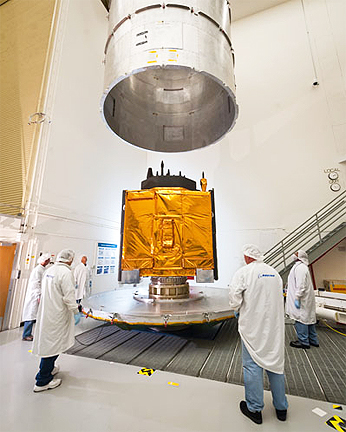
Boeing technicians prepare a GPS satellite for mass properties testing at the company's facility in El Segundo. Mass properties testing ensures that a satellite meets weight, center of gravity, dynamic balance, and moment of inertia requirements in preparation for launch and operation. Boeing GPS testing uses a robust spin rate of 40 rpm. Two GPS IIF satellites are currently in service, two are complete and await launch, and eight are in various stages of manufacture. Photo courtesy of Boeing.
....through the use of a pulse-line manufacturing approach adapted from the Boeing 737 airplane production line. "Using this pulse-line approach, we are able to build up to six satellites per year," said Craig Cooning, vice president and general manager of Boeing Space & Intelligence Systems. "This is the highest satellite production rate in Boeing history, and it ensures we will deliver the remaining GPS IIF satellites on schedule."
Boeing is currently under contract for 12 GPS IIF satellites for the U.S. Air Force. Two are in orbit and meeting mission requirements; two have been completed and are being stored until launch; and eight are in various stages of pulse-line production. The next GPS IIF launch is scheduled during the third quarter of 2012. Boeing is prepared to deliver several GPS IIF satellites within the next year.
"Similar to an aircraft assembly line, the GPS IIF pulse line efficiently moves a satellite from one designated work area to the next at a fixed rate," said Jan Heide, GPS IIF program director. "Within the four pulse line work centers, we’ve incorporated Lean manufacturing processes, new tooling, and additional work-planning packages to improve efficiency and reduce cost."
The GPS pulse line can accommodate four satellites at any given time. Wait time between tasks is reduced or eliminated by staging necessary parts and tools at the point of use at each workstation, creating a smooth process flow. Along the pulse line, satellites flow to work centers dedicated to four manufacturing stages: vehicle assembly, initial test, thermal-vacuum testing, and final test. The line delivers one space vehicle to storage every two to three months.
GPS IIF is the product of Boeing's long legacy with GPS capabilities, dating back to the first GPS satellite program in 1974. As the prime contractor on the GPS Block I, Block II, Block IIA and Block IIF programs, Boeing has built 40 of the 62 GPS satellites launched since 1978. For nearly 40 years Boeing has worked with the U.S. Air Force to help ensure excellent service to nearly 1 billion military and civilian users around the world. Boeing also is the prime contractor for the Operational Control Segment, which has supported an expanding set of GPS services and capabilities since 2007.

